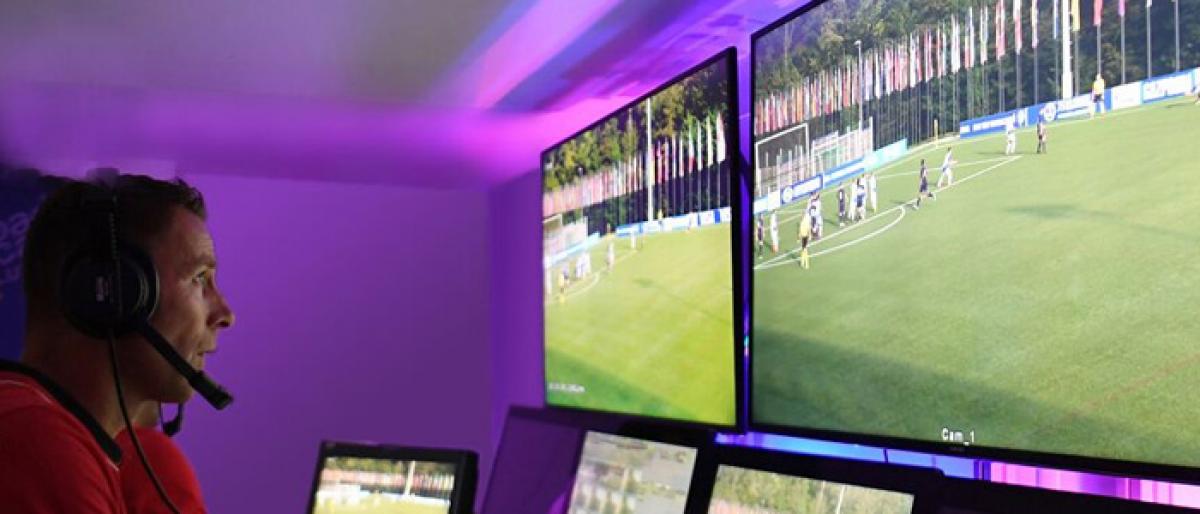Live
- Palle Sindhura Reddy flays YS Jagan during election campaign in Puttaparthi
- Senior JSP leader Manukranth Reddy quits party, joins YSRCP
- Asad files nomination papers for Hyd’bad Lok Sabha seat
- GHMC implements weekly ‘basti’ action plan
- NDA will sweep polls in State, says Balayya
- Hyderabad: Mother kills self over threats to son
- Hyderabad: Mishap on ORR claims two lives
- Anjuman Agiary bags INTACH Heritage Award
- Health dept issues heat advisory for citizens
- Congress, BRS candidates roll out aggressive campaign in Cantonment
Just In

The video assistant referee (VAR) is a football assistant referee who reviews decisions made by the head referee with the use of video footage and a headset for communication. In 2018 VARs were written into the Laws of the Game by the International Football Association Board (IFAB) following trials in a number of major competitions.
The video assistant referee (VAR) is a football assistant referee who reviews decisions made by the head referee with the use of video footage and a headset for communication. In 2018 VARs were written into the Laws of the Game by the International Football Association Board (IFAB) following trials in a number of major competitions.
The role of VARs is to assist the referee to determine whether there was an infringement that means a goal should not be awarded. As the ball has crossed the line, play is interrupted so there is no direct impact on the game; ensure that no clearly wrong decisions are made in conjunction with the award or non-award of a penalty kick; ensure that no clearly wrong decisions are made in conjunction with sending off or not sending off a player and help the referee to caution or send off the wrong player, or is unsure which player should be sanctioned. The VAR will inform the referee so that the correct player can be disciplined.
The standard for overturning the referee's original decision is that there has been a "clear error", sometimes expanded to "clear and obvious error".
The process begins with the video assistant referee(s) and the assistant video assistant referee (AVAR) reviewing the play in question on a bank of monitors in the video operation room (VOR) with the assistance of the replay operator (RO).
This can be triggered by the referee requesting the review or by the VAR conducting a "check" to see if he or she should recommend a review to the referee. If the VAR finds nothing during the check, then communication with the referee is unnecessary, which is called a "silent check". If the VAR believes there has been a potential clear error, he or she will contact the referee with that judgment.
The referee can then either (a) change the call on the advice of the VAR or (b) conduct an on-field review (OFR) by going to a designated spot on the sideline, called the referee review area (RRA), to review the video with the help of the review assistant (RA) or (c) decide that he/she is confident in the original call and not conduct an OFR. The referee is allowed to stop play to reverse a call or conduct an OFR, but is not supposed to do so when either team is engaged in good attacking possibility.
The International Football Association Board (IFAB), the body that determines the Laws of the Game, approved the use of video referees in trials during its 2016 Annual General Meeting. On March 3, 2018, the IFAB wrote the VARs into the Laws of the Game on a permanent basis.
The assistant video assistant referee (AVAR) is a current or former referee appointed to assist the VAR in the VOR. The responsibilities of the AVAR include watching the live action on the field while the VAR is undertaking a "check" or a "review", to keep notes of incidents, and to communicate the outcome of a review to broadcasters.

© 2024 Hyderabad Media House Limited/The Hans India. All rights reserved. Powered by hocalwire.com







